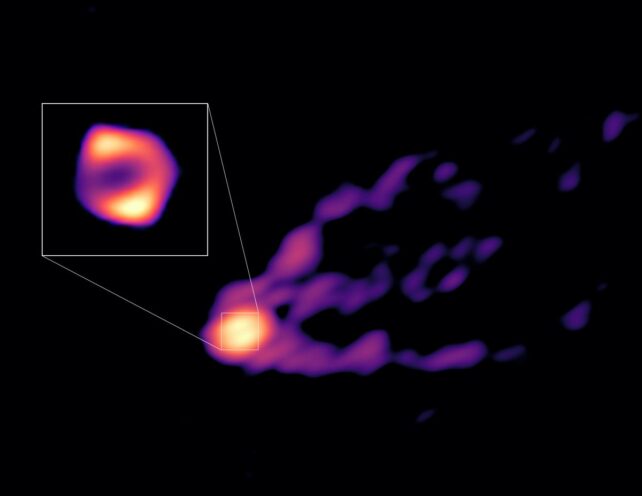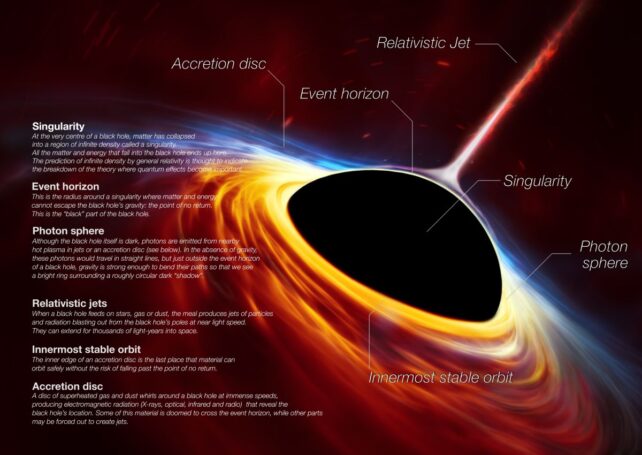
New images of the Universe's most photogenic pit of darkness are providing insight into a mysterious black hole behavior.
For the first time, we are looking at the source of a colossal jet of plasma blasting into space from the edge of supermassive black hole M87*. It's also the first time that we've seen the shadow of a black hole and its jet together in the same image, a view that should help astronomers figure out how these giant streams of plasma are generated.
"We know that jets are ejected from the region surrounding black holes," says astronomer Ru-Sen Lu from the Shanghai Astronomical Observatory in China, "but we still do not fully understand how this actually happens. To study this directly we need to observe the origin of the jet as close as possible to the black hole."

Black holes, as we all know, are famous for not emitting anything we can detect. They're so dense that space-time effectively warps into a closed sphere around them, so that no speed in the Universe is sufficient to achieve escape velocity. But the space just outside the boundary of that ball – what we call the event horizon – is another matter.
Here is a region of extremes, where gravity reigns supreme. Any material nearby is caught in its snare, swirling into a disk of material that pours onto the black hole like water down a drain. The friction and gravity heat this material, causing it to glow; that's what we saw in the now-famous image of M87* first released in 2019, from data collected in 2017 by the Event Horizon Telescope (EHT) collaboration.
But not all the material inevitably gets drawn beyond the event horizon. Some of it skims the edge before being launched into space from the black hole's polar regions, forming jets that can travel at a significant percentage of the speed of light and punch vast distances into interstellar space.
Astronomers believe this material is diverted from the inner rim of the disk along the magnetic field lines outside the event horizon. These magnetic field lines accelerate the particles so that when they reach the poles, they are launched at great speed out into space.
That's the broad strokes; the specifics are more difficult to pin down. We know that M87* has a jet that reaches 100,000 light-years in radio wavelengths, which is about the diameter of our own galaxy. So, in 2018, astronomers used powerful radio telescopes united to form the Global mm-VLBI Array (GMVA) to see if they could capture the region from which the jets launch in detail. It collected data in a longer wavelength than the EHT, revealing different information.
"M87 has been observed over many decades, and 100 years ago we knew the jet was there, but we couldn't place it in context," Lu says. "With GMVA, including the premier instruments at NRAO and GBO, we're observing at a lower frequency so we're seeing more detail – and now we know there are more details to see."

The galaxy M87 is located around 55 million light-years away, and hosts a supermassive black hole around 6.5 billion times the mass of the Sun, actively accreting matter from a disk around it. The image captured by the EHT showed, for the first time, the shadow of that black hole – a dark region in the midst of a glowing ring of material, distorted by the gravitational curvature of space time.
The new image shows a broader region of space than the EHT image. It reveals that the extent of the plasma around M87* is much larger than we see in the EHT image, in addition to the source of the jet.
"The original EHT imaging revealed only a portion of the accretion disk surrounding the center of the black hole. By changing the observing wavelengths from 1.3 millimeters to 3.5 millimeters, we can see more of the accretion disk, and now the jet, at the same time," says astronomer Toney Minter of the National Radio Astronomy Observatory. "This revealed that the ring around the black hole is 50 percent larger than we previously believed."
The new image also revealed new information about how the jet is launched from the region of space around the black hole, affirming magnetic field lines do indeed play a critical role in whisking material away to be launched as jets.
But they don't act alone. A powerful wind emanates from the disk itself, powered by radiation pressure. This wind, the image shows, contributes to the creation of the M87 jet.
This is a pretty significant breakthrough in black hole science, but the researchers aren't done. There's a lot more to see in the entire radio spectrum, and M87* has proven that it can deliver.
"We plan to observe the region around the black hole at the center of M87 at different radio wavelengths to further study the emission of the jet," says astronomer Eduardo Ros from the Max Planck Institute for Radio Astronomy in Germany. "The coming years will be exciting, as we will be able to learn more about what happens near one of the most mysterious regions in the Universe."
The research has been published in Nature.





No comments:
Post a Comment